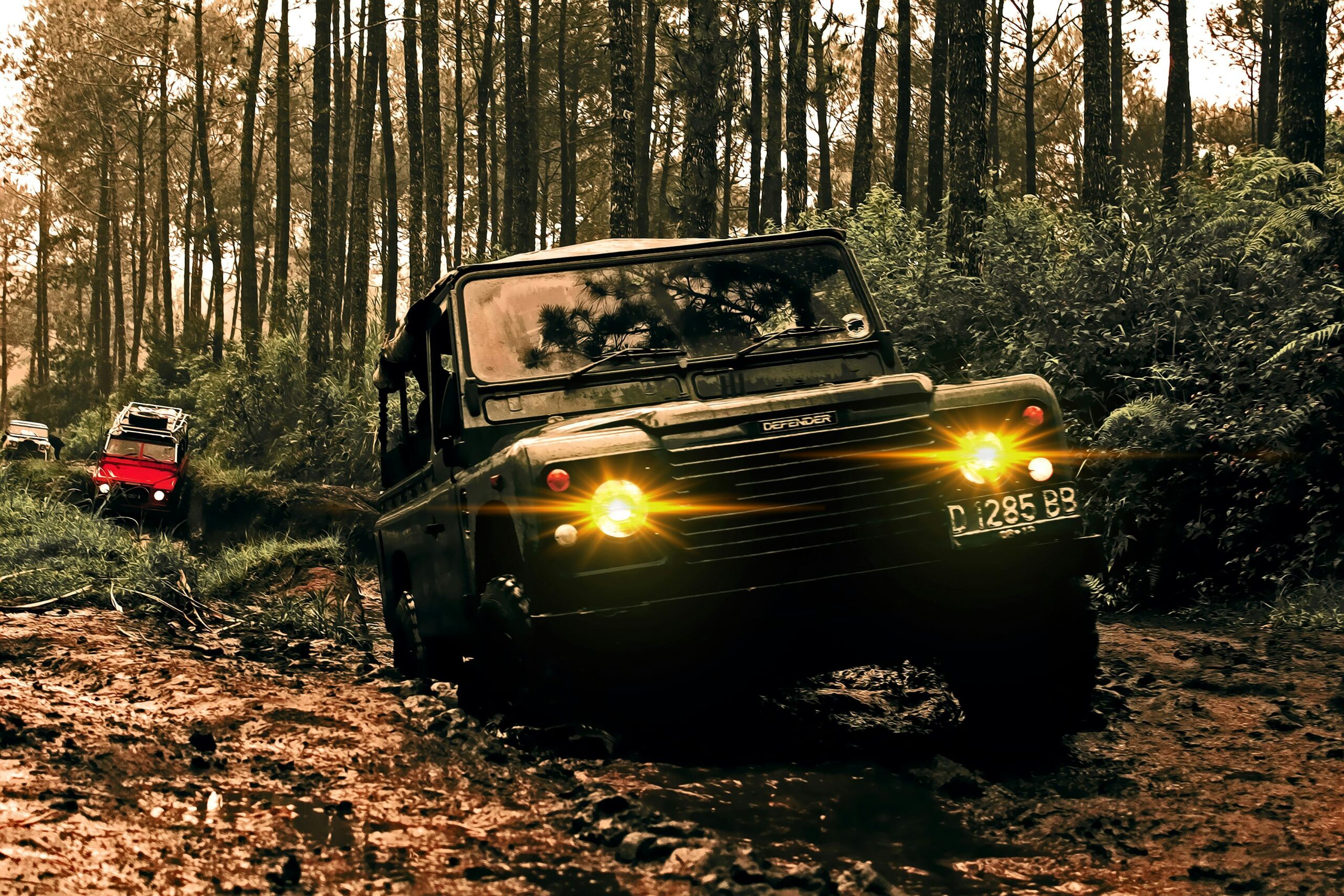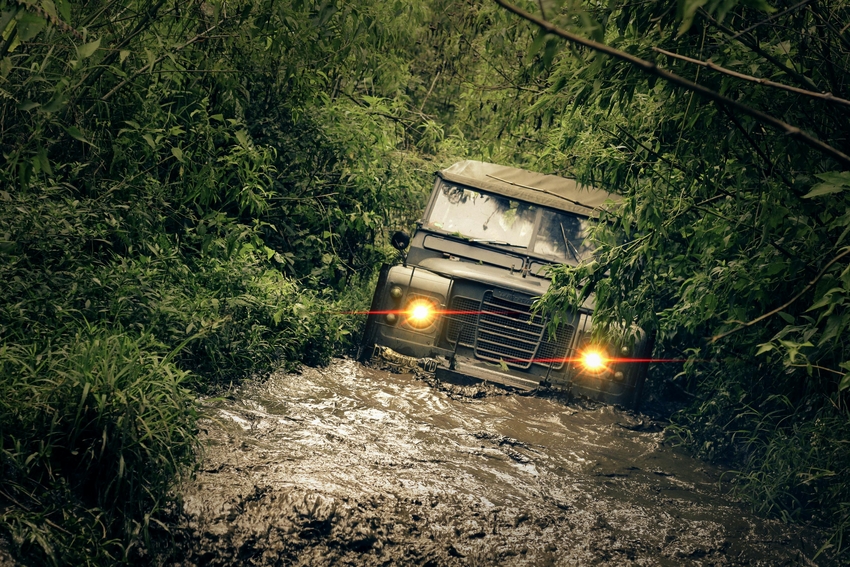
Welcome to our guide on off-road safety essentials for Land Rover enthusiasts! As passionate adventurers, we understand the thrill of exploring rugged terrain and remote destinations in our beloved Land Rovers. However, embarking on off-road adventures comes with its share of risks and challenges. That’s why it’s essential to prioritize safety by equipping yourself with the right gear and preparation techniques. In this comprehensive guide, we’ll cover everything you need to know to stay safe and prepared while off-roading in your Land Rover.
Understanding Off-Road Risks: The Importance of Safety
Before we delve into safety gear and preparation tips, let’s take a moment to understand the inherent risks associated with off-road driving. Unlike paved roads, off-road trails can present a variety of challenges, including uneven terrain, steep inclines, water crossings, and unpredictable weather conditions. Without proper preparation and caution, these obstacles can lead to accidents, injuries, and vehicle damage.
As responsible off-roaders, it is our duty to prioritize safety at all times. Whether you’re embarking on a day trip to your favorite off-road trail or planning an extended overland adventure, taking the necessary precautions can make all the difference between a successful outing and a potential disaster. By equipping yourself with the right safety gear and knowledge, you can enjoy off-road adventures with confidence and peace of mind.
Essential Safety Gear for Off-Road Adventures
When it comes to off-road safety, preparation is key. Before hitting the trails in your Land Rover, make sure you have the following essential safety gear on hand:
- First Aid Kit: A well-stocked first aid kit is essential for treating minor injuries and medical emergencies while off-roading. Make sure your kit includes bandages, gauze pads, antiseptic wipes, adhesive tape, scissors, tweezers, pain relievers, and any necessary medications.
- Recovery Gear: Off-road recovery gear is essential for extricating your vehicle from challenging situations such as mud, sand, or snow. Basic recovery gear includes a tow strap, recovery straps, D-rings, shackles, and a high-lift jack. Familiarize yourself with how to use this equipment safely and effectively before heading off-road.
- Communication Devices: In remote off-road areas, communication can be limited or nonexistent. That’s why it’s essential to carry reliable communication devices such as a two-way radio, satellite phone, or personal locator beacon (PLB) to call for help in case of emergencies. Make sure your devices are fully charged and in working condition before setting out on your off-road adventure.
- Navigation Tools: Getting lost in the wilderness is a common concern for off-roaders. To avoid getting lost, always carry navigation tools such as a GPS device, paper maps, compass, and a reliable smartphone with offline maps. Familiarize yourself with your chosen navigation tools and practice using them before your off-road adventure.
- Emergency Supplies: In addition to first aid and recovery gear, it’s essential to carry emergency supplies such as water, food, blankets, a flashlight, extra batteries, a multi-tool, and a fire extinguisher. These supplies can help you stay safe and comfortable in case of unexpected delays or emergencies.
By ensuring you have the right safety gear on hand, you can mitigate potential risks and handle emergencies effectively while off-roading in your Land Rover.

Preparation Techniques for Off-Road Adventures
In addition to having the right safety gear, proper preparation is essential for a successful off-road adventure. Here are some preparation techniques to consider before hitting the trails:
- Know Your Vehicle: Before venturing off-road, take the time to familiarize yourself with your Land Rover’s capabilities and limitations. Understand how to engage four-wheel drive, use differential locks, and operate other off-road features. Practice driving in different terrain conditions to build confidence and skill behind the wheel.
- Inspect Your Vehicle: Perform a thorough inspection of your Land Rover before heading off-road. Check tire pressure, fluid levels, brakes, lights, and other essential components to ensure everything is in good working condition. Address any issues or concerns before hitting the trail to prevent breakdowns or accidents.
- Plan Your Route: Before setting out on your off-road adventure, plan your route carefully and research the trail conditions, difficulty level, and potential hazards. Use maps, guidebooks, and online resources to familiarize yourself with the trail and identify any points of interest or landmarks along the way. Let someone know your itinerary and expected return time, especially if you’re traveling alone or in remote areas.
- Check the Weather: Weather conditions can significantly impact off-road driving conditions. Before heading out, check the weather forecast for your destination and be prepared for changes in weather conditions. Avoid driving in severe weather such as heavy rain, snow, or high winds, as these conditions can increase the risk of accidents and vehicle damage.
- Travel with a Buddy: Whenever possible, off-road with a buddy or in a group to provide additional safety and support. Traveling with others can provide assistance in case of emergencies, share driving responsibilities, and offer camaraderie during your off-road adventures. Make sure to establish clear communication channels and a plan for staying together on the trail to avoid getting separated.
- Practice Safe Driving Techniques: Off-road driving requires a different set of skills compared to driving on paved roads. Practice safe driving techniques such as maintaining a steady speed, keeping a safe distance from other vehicles, and avoiding sudden maneuvers that could lead to loss of control. Use caution when navigating steep inclines, descents, and obstacles, and always follow designated trails to minimize environmental impact.
- Stay Alert and Focused: Off-road driving requires constant attention and focus to anticipate potential hazards and obstacles. Stay alert while behind the wheel, scan the trail ahead for rocks, branches, and other obstacles, and be prepared to react quickly to changing terrain conditions. Avoid distractions such as texting, talking on the phone, or engaging in other activities that could divert your attention from the task at hand.
- Respect Nature and Leave No Trace: Off-road enthusiasts have a responsibility to protect the environment and minimize their impact on fragile ecosystems. Follow the principles of Leave No Trace by packing out all trash and waste, staying on designated trails, and avoiding damage to vegetation and wildlife habitats. Practice responsible off-roading techniques such as minimizing wheel spin, avoiding unnecessary revving, and steering clear of sensitive areas such as wetlands and streambeds.
- Be Prepared for Emergencies: Despite taking all necessary precautions, emergencies can still occur while off-roading. Be prepared to handle emergencies by carrying a well-equipped emergency kit, knowing how to administer first aid, and having a plan for summoning help if needed. Stay calm and composed in stressful situations, and rely on your training and preparation to guide your actions.
- Know When to Turn Back: Off-roading is all about pushing the limits and exploring new terrain, but it’s essential to know when to call it quits. If you encounter impassable obstacles, inclement weather, or other hazards that pose a significant risk to your safety, don’t hesitate to turn back and find an alternate route. Remember, it’s better to err on the side of caution than to risk injury or vehicle damage.
By following these safety essentials and preparation techniques, you can enjoy off-road adventures in your Land Rover with confidence and peace of mind. Remember, safety should always be your top priority, so take the time to prepare properly and equip yourself with the knowledge and gear you need to stay safe on the trails.
In the next section, we’ll discuss specific safety tips for various off-road scenarios, including driving on different types of terrain and navigating challenging obstacles. Stay tuned for more expert advice on off-road safety for Land Rover enthusiasts!

Specific Safety Tips for Off-Roading in Different Scenarios
Now that we’ve covered the essential safety gear and preparation techniques, let’s dive into specific safety tips for off-roading in different scenarios. Whether you’re navigating rocky trails, traversing sandy dunes, or crossing water obstacles, it’s essential to adapt your driving techniques and approach to ensure a safe and enjoyable off-road experience. Here are some safety tips for common off-road scenarios:
- Driving on Rocky Terrain:
- Choose the Right Line: When tackling rocky terrain, choose your driving line carefully to avoid large rocks, boulders, and other obstacles. Look for the smoothest path possible and use your vehicle’s ground clearance to your advantage.
- Maintain Momentum: Maintain a steady speed and momentum when driving over rocky terrain to reduce the risk of getting stuck or high-centering your vehicle. Avoid sudden stops or changes in direction that could cause your vehicle to lose traction.
- Use Proper Tire Pressure: Adjust your tire pressure to the recommended levels for off-road driving to maximize traction and improve ride comfort on rocky terrain. Lowering tire pressure can help increase the contact patch and improve grip on uneven surfaces.
- Navigating Sandy or Loose Terrain:
- Reduce Tire Pressure: Lowering your tire pressure can help improve traction and floatation on sandy or loose terrain. Reduce tire pressure to the recommended levels for off-road driving to prevent getting bogged down in soft sand or gravel.
- Maintain Forward Momentum: When driving on sandy or loose terrain, maintain a consistent forward momentum to keep your vehicle moving and prevent getting stuck. Avoid sudden stops or changes in direction that could cause your vehicle to dig into the sand or lose traction.
- Avoid Spinning Your Tires: Spinning your tires in sand or loose gravel can dig a hole and make it more challenging to extricate your vehicle. If you feel your tires starting to spin, gently ease off the throttle and try rocking the vehicle back and forth to gain traction.
- Crossing Water Obstacles:
- Check Water Depth and Conditions: Before crossing a water obstacle, check the depth and condition of the water to ensure it’s safe to proceed. Avoid crossing deep or fast-flowing water unless you’re confident in your vehicle’s ability to handle the conditions.
- Maintain a Slow, Steady Pace: When crossing water obstacles, maintain a slow, steady pace to minimize the risk of hydro-locking your engine or causing water ingress into the cabin. Use a low gear and keep your engine RPMs steady to prevent stalling or loss of momentum.
- Check for Hidden Hazards: Be on the lookout for hidden hazards such as submerged rocks, logs, or debris that could damage your vehicle or impede your progress. Take your time and proceed cautiously to ensure a safe crossing.
- Climbing Steep Inclines or Descents:
- Use Low Range and Low Gear: When climbing steep inclines or descents, engage low range and select a low gear to maximize traction and control. Use engine braking to maintain a slow, controlled descent and avoid relying solely on your brakes, which can overheat and lose effectiveness.
- Maintain a Safe Distance: When following other vehicles up or down steep inclines, maintain a safe distance to allow for adequate braking distance and maneuvering space. Avoid tailgating or following too closely, as this can increase the risk of accidents or collisions.
- Watch for Loose Rocks and Debris: Be on the lookout for loose rocks, gravel, or debris that could cause your vehicle to lose traction or slip on steep inclines or descents. Adjust your driving line as needed to avoid obstacles and maintain control of your vehicle.
By following these specific safety tips for off-roading in different scenarios, you can navigate challenging terrain with confidence and minimize the risk of accidents or vehicle damage. Remember to always prioritize safety and adapt your driving techniques to suit the conditions and terrain you’re encountering.
In the final section of our guide, we’ll discuss additional safety considerations, including vehicle recovery techniques and emergency protocols. Stay tuned for more expert advice on off-road safety for Land Rover enthusiasts!
Additional Safety Considerations: Vehicle Recovery Techniques and Emergency Protocols
As off-road enthusiasts, it’s essential to be prepared for the unexpected and know how to handle emergencies and vehicle recovery situations effectively. In this final section of our guide, we’ll discuss additional safety considerations, including vehicle recovery techniques and emergency protocols to help you stay safe while off-roading in your Land Rover.
- Vehicle Recovery Techniques:
Off-road driving inevitably comes with the risk of getting stuck or bogged down in challenging terrain. Knowing how to recover your vehicle safely and efficiently is crucial for a successful off-road adventure. Here are some essential vehicle recovery techniques to keep in mind:
- Self-Recovery with Traction Aids: If your vehicle becomes stuck in mud, sand, or snow, you may be able to free yourself using traction aids such as recovery boards, sand tracks, or traction mats. Place the traction aids in front of or behind your tires, depending on the direction of travel, and slowly drive onto them to gain traction and extricate your vehicle.
- Winching: A winch is a valuable tool for recovering vehicles from challenging situations such as steep inclines, deep mud, or off-camber terrain. Attach the winch cable to a secure anchor point such as a tree or rock, and use the winch to pull your vehicle out of the obstacle. Always use a properly rated winch and follow safe winching practices to prevent accidents or injuries.
- Tow Straps and Recovery Points: Tow straps and recovery points are essential components of any off-road recovery kit. If another vehicle is available, use a tow strap or recovery strap to pull your vehicle out of a stuck situation. Attach the strap to designated recovery points on both vehicles and use slow, steady traction to pull the stuck vehicle to safety.
- Hi-Lift Jack Recovery: A hi-lift jack is a versatile tool that can be used for a variety of vehicle recovery tasks, including lifting, winching, and pulling. Use caution when using a hi-lift jack, as improper use can lead to accidents or vehicle damage. Familiarize yourself with the proper techniques for using a hi-lift jack and always use jack stands or cribbing for stability.
- Emergency Protocols:
Despite taking all necessary precautions, emergencies can still occur while off-roading. Knowing how to respond to emergencies and summoning help when needed is essential for your safety and the safety of your passengers. Here are some emergency protocols to keep in mind:
- Stay Calm and Assess the Situation: In the event of an emergency, stay calm and assess the situation before taking any action. Determine the severity of the situation and prioritize your safety and the safety of your passengers.
- Call for Help: If you’re unable to resolve the emergency on your own, call for help using your communication device or satellite phone. Provide your location, a description of the emergency, and any other relevant information to the emergency dispatcher or contact person.
- Follow Safety Protocols: Follow established safety protocols and procedures for handling emergencies, including administering first aid, securing the scene, and evacuating if necessary. Work together with your passengers to ensure everyone’s safety and well-being.
- Wait for Assistance: If you’re unable to resolve the emergency on your own, wait for assistance to arrive. Stay with your vehicle and avoid wandering off into unknown terrain. Use your communication device to stay in contact with emergency responders and provide updates on your situation.
By familiarizing yourself with vehicle recovery techniques and emergency protocols, you can handle unexpected situations with confidence and ensure a safe off-road experience for yourself and your fellow adventurers.
Conclusion: Prioritize Safety and Enjoy Your Off-Road Adventures
Off-roading in your Land Rover is an exhilarating and rewarding experience, but it’s essential to prioritize safety at all times. By equipping yourself with the right safety gear, preparing for off-road scenarios, and knowing how to respond to emergencies, you can enjoy your off-road adventures with confidence and peace of mind.
Remember to always assess the risks and conditions before venturing off-road, adapt your driving techniques to suit the terrain, and follow established safety protocols at all times. With proper preparation and caution, you can explore the great outdoors in your Land Rover while staying safe and responsible.
Thank you for joining us for this guide on off-road safety essentials for Land Rover enthusiasts. We hope you found this information helpful and informative. Now, go out and enjoy your off-road adventures with confidence and enthusiasm!


